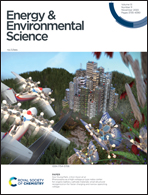Quantitative temporally and spatially resolved X-ray fluorescence microprobe characterization of the manganese dissolution-deposition mechanism in aqueous Zn/α-MnO2 batteries†
Abstract
Rechargeable aqueous Zn/α-MnO2 batteries are a possible alternative to lithium ion batteries for scalable stationary energy storage applications due to their low cost, safety and environmentally benign components. A critical need for advancement of this battery system is a full understanding of the electrochemical reaction mechanisms, which remain unclear. In this report, operando, spatiotemporal resolved synchrotron X-ray fluorescence mapping measurements on a custom aqueous Zn/α-MnO2 cell provided direct evidence of a Mn dissolution-deposition faradaic mechanism that governs the electrochemistry. Simultaneous visualization and quantification of the Mn distribution in the electrolyte revealed the formation of aqueous Mn species during discharge and depletion on charge. The findings are supported by ex situ transmission electron microscopy (TEM), X-ray diffraction, Mn K-edge X-ray absorption near edge structure (XANES) and extended X-ray absorption fine structure (EXAFS) measurements. The elucidated mechanism is fundamentally different from the previously proposed Zn2+ insertion or conversion reactions. These findings provide a foundation for developing dissolution- deposition chemistries suitable for scalable stationary energy storage with aqueous electrolyte.



 Please wait while we load your content...
Please wait while we load your content...